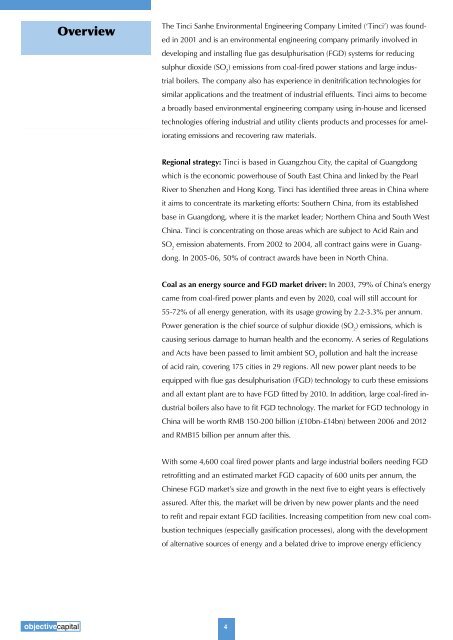Objective Capital Research Report_Summary - Tinci Holdings Limited
Objective Capital Research Report_Summary - Tinci Holdings Limited
Objective Capital Research Report_Summary - Tinci Holdings Limited
Create successful ePaper yourself
Turn your PDF publications into a flip-book with our unique Google optimized e-Paper software.
objectivecapital<br />
Overview<br />
The <strong>Tinci</strong> Sanhe Environmental Engineering Company <strong>Limited</strong> (‘<strong>Tinci</strong>’) was found-<br />
ed in 2001 and is an environmental engineering company primarily involved in<br />
developing and installing flue gas desulphurisation (FGD) systems for reducing<br />
sulphur dioxide (SO 2 ) emissions from coal-fired power stations and large indus-<br />
trial boilers. The company also has experience in denitrification technologies for<br />
similar applications and the treatment of industrial effluents. <strong>Tinci</strong> aims to become<br />
a broadly based environmental engineering company using in-house and licensed<br />
technologies offering industrial and utility clients products and processes for amel-<br />
iorating emissions and recovering raw materials.<br />
Regional strategy: <strong>Tinci</strong> is based in Guangzhou City, the capital of Guangdong<br />
which is the economic powerhouse of South East China and linked by the Pearl<br />
River to Shenzhen and Hong Kong. <strong>Tinci</strong> has identified three areas in China where<br />
it aims to concentrate its marketing efforts: Southern China, from its established<br />
base in Guangdong, where it is the market leader; Northern China and South West<br />
China. <strong>Tinci</strong> is concentrating on those areas which are subject to Acid Rain and<br />
SO 2 emission abatements. From 2002 to 2004, all contract gains were in Guang-<br />
dong. In 2005-06, 50% of contract awards have been in North China.<br />
Coal as an energy source and FGD market driver: In 2003, 79% of China’s energy<br />
came from coal-fired power plants and even by 2020, coal will still account for<br />
55-72% of all energy generation, with its usage growing by 2.2-3.3% per annum.<br />
Power generation is the chief source of sulphur dioxide (SO 2 ) emissions, which is<br />
causing serious damage to human health and the economy. A series of Regulations<br />
and Acts have been passed to limit ambient SO 2 pollution and halt the increase<br />
of acid rain, covering 175 cities in 29 regions. All new power plant needs to be<br />
equipped with flue gas desulphurisation (FGD) technology to curb these emissions<br />
and all extant plant are to have FGD fitted by 2010. In addition, large coal-fired in-<br />
dustrial boilers also have to fit FGD technology. The market for FGD technology in<br />
China will be worth RMB 150-200 billion (£10bn-£14bn) between 2006 and 2012<br />
and RMB15 billion per annum after this.<br />
With some 4,600 coal fired power plants and large industrial boilers needing FGD<br />
retrofitting and an estimated market FGD capacity of 600 units per annum, the<br />
Chinese FGD market’s size and growth in the next five to eight years is effectively<br />
assured. After this, the market will be driven by new power plants and the need<br />
to refit and repair extant FGD facilities. Increasing competition from new coal com-<br />
bustion techniques (especially gasification processes), along with the development<br />
of alternative sources of energy and a belated drive to improve energy efficiency<br />
4


